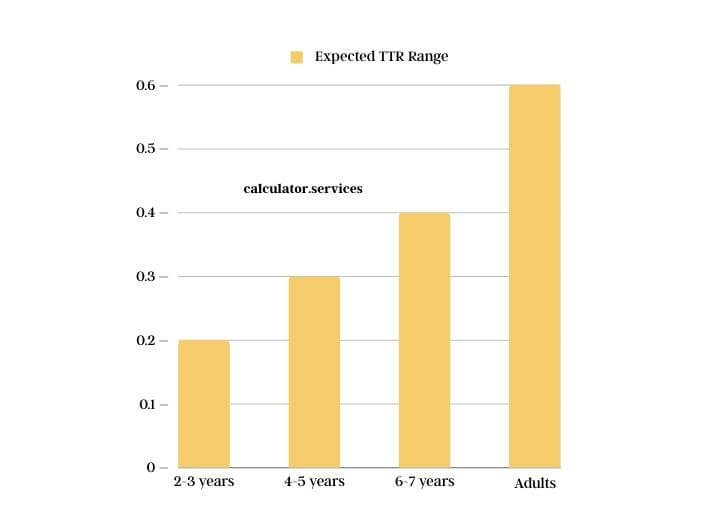Published on: November 16, 2023
Created by Calculator Services Team / Fact-checked by Monjurul Kader
Type-Token Ratio (TTR) Calculator
Result:
The Type Token Ratio (TTR) calculator is a specialized tool designed to measure the lexical diversity within a given language sample. This ratio is particularly useful in linguistic studies and language development research. The TTR is calculated by dividing the total number of unique words (types) by the total number of words (tokens) in the sample. This simple yet effective measure provides insights into the richness of vocabulary in a text or speech sample.
Understanding the TTR is essential in various fields, especially in assessing language development. The norms for TTR vary by age, making it a valuable tool in developmental linguistics and speech therapy. The American Speech-Language-Hearing Association (ASHA) provides guidelines on TTR norms, which are crucial for professionals in assessing language proficiency and development. In educational settings, TTR helps in evaluating students’ language abilities, guiding curriculum development to enhance linguistic skills.
For researchers and linguists, TTR calculation is a key component in their toolkit. The advent of type token ratio software has simplified this process, allowing for quicker and more accurate analysis of large text samples. This is particularly useful in studies involving language sample analysis, where manual calculations can be time-consuming and prone to error.
The TTR also finds its application in clinical settings, such as in calculating TTR for warfarin, a medication requiring careful monitoring. Here, the TTR provides a measure of the variability in the effectiveness of the drug, ensuring safe and effective dosing.
For those interested in what the Type-Token Ratio measures and its applications across various fields, our detailed article below offers comprehensive insights. Whether you are a student, researcher, or professional, the information provided will enhance your understanding of this important linguistic metric.
See More Useful Calculators:
- Coolant Mix Ratio Calculator
- Starting Line Ratio Calculator
- Aldosterone-Renin Ratio Calculator
- Meat to Fat Ratio Calculator
- Infusion Molar Ratio Calculator
- Weller Gear Ratio Calculator

Know the Type Token Ratio
Definition and Importance
Have you ever wondered how linguists measure the richness of vocabulary in a language sample? Enter the Type Token Ratio (TTR), a handy tool in the linguist’s toolkit. It’s a simple concept: divide the number of unique words (types) by the total number of words (tokens) in a sample. This ratio gives us a peek into how varied a person’s vocabulary is. It’s like having a microscope that zooms in on the diversity of words in any given text or conversation.
Historical Background
The concept of TTR isn’t new. It’s been around for decades, serving as a cornerstone in linguistic research. Initially, it helped researchers understand language development in children. Over time, its use expanded into various fields, from education to computational linguistics, offering insights into how we use language.
The Formula Behind TTR
Mathematical Explanation
The beauty of the TTR lies in its simplicity. The formula is straightforward: TTR = (Number of Types) / (Number of Tokens). Imagine you have a text with 100 words, and 50 of those words are unique. Your TTR would be 50/100, which simplifies to 0.5. This number, often expressed as a percentage, tells you half the words in your text are unique.
Sample TTR Calculations
| Text Sample | Total Words (Tokens) | Unique Words (Types) | TTR |
| Sample A | 100 | 50 | 0.50 |
| Sample B | 200 | 100 | 0.50 |
| Sample C | 150 | 60 | 0.40 |

TTR in Linguistics and Language Development
Role in Language Research
In the world of linguistics, TTR is like a Swiss Army knife. It’s versatile and provides valuable insights. Researchers use it to study everything from language acquisition in toddlers to the complexity of literary works. It’s especially useful in comparing the linguistic development across different age groups or assessing the impact of language disorders.
TTR Norms by Age
Age-wise TTR Norms
| Age Group | Expected TTR Range |
| 2-3 years | 0.2 – 0.3 |
| 4-5 years | 0.3 – 0.5 |
| 6-7 years | 0.4 – 0.6 |
| Adults | 0.6 – 0.7 |

Practical Applications of TTR
Educational Uses
In education, TTR is a game-changer. Teachers use it to track students’ language development, tailoring their teaching methods to enhance vocabulary diversity. It’s a window into a student’s linguistic world, helping educators identify those who might need extra support or challenge.
Clinical Implications
In clinical settings, TTR helps speech therapists assess and treat language disorders. It’s a non-invasive way to measure progress in language therapy, providing tangible goals for patients and therapists alike.
Type Token Ratio Software Tools
Advancements in TTR Calculation
Gone are the days of manually calculating TTR. Today, various software tools make this task a breeze, offering quick and accurate analysis. These tools are particularly useful for handling large text samples, where manual calculation would be impractical.
Comparing Popular TTR Software
Let’s look at some popular TTR software tools. Each has its unique features, but they all aim to simplify the TTR calculation process. Whether you’re a researcher dealing with extensive data or a teacher looking to quickly assess a student’s work, there’s a tool out there for you.
So, there you have it – a whirlwind tour of the Type Token Ratio calculator. From its humble beginnings in linguistic research to its modern applications in education and clinical settings, TTR remains a vital tool for understanding language diversity. It’s amazing how a simple ratio can open up a world of insights into how we use words. Whether you’re a language enthusiast or a professional in the field, the TTR calculator is something to appreciate and utilize.

